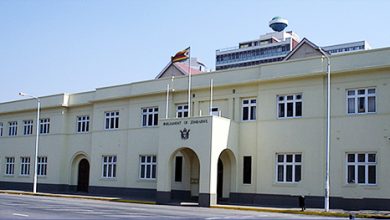Zim economic growth projected at 3.8 percent in 2023

Zimbabwe’s economy is projected to grow by 3.8 percent next year down from the 4 percent forecast for this year, which is also a downward revision from the mid-year projection of 4.6 percent.
Presenting his 2023 national budget in Parliament Thursday, in which total revenue collections are projected at ZWL$3.9 trillion, Finance and Economic Development Minister, Professor Mthuli Ncube, set expenditures at ZWL$4.2 trillion.
“Mr Speaker Sir, in line with the projected real GDP growth rate of 3.8% and a nominal GDP of ZWL$21.8 trillion, total revenue collections are projected at ZWL$3.9 trillion (18% of GDP), whilst expenditures are set at ZWL$4.2 trillion (19.5% of GDP) in 2023,” said the Finance Minister.
“An overall deficit of ZWL$336.9 billion (1.5% GDP) is projected in 2023 and loan repayments amounting to ZWL$248.6 billion, resulting in total financing requirement of ZWL$585.5 billion during 2023, to be financed through VFEX (Victoria Falls Stock Exchange) bond issuance, external loan disbursement; treasury bills issuances, and SDR drawdown.”
The 3.8 percent growth, Ncube said would be sustained by mining, construction and agriculture, as well as accommodation sectors, adding it will be underpinned by assumptions on global economic growth slowing down; favourable international commodity prices; normal to above normal rainfall, stable power supply, tight monetary and fiscal policy; and continued use of the multi-currency.
“In 2023, the country’s external sector is also expected to remain relatively strong, with a positive current account, sustained by strong secondary income inflows, mainly remittances, coupled with merchandise exports growing faster than imports,” said Ncube.
“Mr Speaker Sir, the banking sector has demonstrated resilience as reflected by satisfactory financial soundness indicators, bolstered by complementary fiscal and monetary policy interventions, meant to ensure financial sector stability.”
Ncube decreased the Intermediate Money Transfer Tax (IMTT) on domestic foreign currency transfers from 4% to 2%.
“Mr Speaker Sir, in order to promote usage of the local currency, the Government increased Intermediate Money Transfer Tax (IMTT) on domestic foreign currency transfers from 2% to 4%,” he said.
“It has, however, been observed that some entities are now preferring to settle transactions in cash, instead of electronic transfers. In order to promote use of the banking system, I propose to align IMTT on foreign currency transactions to the rate applicable to local currency transactions at 2%.”
Meanwhile, the Finance Minister disclosed the cumulative revenue collections to September 2022 amounted to ZWL$1.2 trillion, against a target of ZWL$890.5 billion, giving a positive variance of Z W$269.9 billion.
“Tax and nontax revenue collections amounted to ZWL$1.1 trillion and ZWL$71.7 billion, respectively,” he said.
“Revenue collections to year end remain on course to meet the revised target of ZWL$1.7 trillion. Cumulative expenditures to September 2022 stood at ZWL$1.19 trillion against a target of ZWL$1.02 trillion, representing an expenditure overrun of ZWL$173.9 billion. To year-end, total expenditures are estimated to reach ZWL$1.90 trillion.
The country’s total Public and Publicly Guaranteed (PPG) debt is estimated at ZWL$2.2 trillion for domestic debt and US$14 billion for external debt as at the end September 2022.
“Mr Speaker Sir, during the first nine months of 2022, the country received development assistance amounting to US$641.9 million, of which US$405.7 million was from bilateral partners and US$236.3 million from multilateral partners to support various projects and programmes,” said Ncube.
“In 2023, Development Partners are projected to disburse US$352.8 million, mainly targeting social sectors and governance.”






